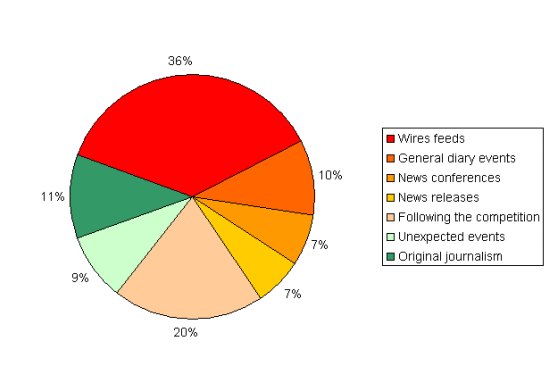
This article looks at how media organisations need to plan ahead in order to produce original content that informs the public debate and makes the most efficient use of resources.
In a previous article which covered ‘‘Establishing a market differential’ we looked at how a media organisation can develop a content strategy aimed at producing more than 10 original stories a week. All the stories would be focused on the needs of a clearly-defined target audience. Now we look at how those stories should be managed.
First of all, ask yourself this question: Are you in control of your news organisation’s editorial agenda?
You might think you are, but an examination of what prompts or stimulates you to cover news might reveal flaws in your news strategy.
It could be that the majority of the news you cover on any given day is directly or indirectly controlled by others.
A forward planning strategy, based on original, issue-led journalism, can reverse this.
Forward planning is not about the everyday diary events that all are aware of. That is day to day planning. Forward planning is far more important in terms of setting your media organisation apart from the competition. It’s fundamental to a converged newsroom strategy delivering content to multiple devices.
Typical sources of news
Let’s look at some typical sources of news:
- The news wires that you subscribe to
- Diary events that are publicly available
- News conferences called by politicians, businesses, NGOs etc
- News releases sent by public relations companies
- Following the stories the competition has produced
- Dealing with unexpected events
- Monitoring social media
- Exploring unique angles to ongoing stories
- Stories produced by examining data
- Keeping in touch with contacts
- Investigative journalism
- Planned thematic coverage (such as health, environment, crime etc)
The problem is that some media organisations rely on the first six sources.
However, a modern, responsible media organisation, that exists to inform the public debate with thorough, objective, fair and accurate journalism, will spend time investing in the last six sources of news, particularly the final category – planned coverage.
And this is where the planning editor comes in.
Taking control of your news agenda
It’s worth analysing what prompts or stimulates the news decisions in your media organisation. The results might make uncomfortable reading.
It could be that the majority of the news you cover is stimulated by others.
In 2013, senior editors who have worked at three global news organisations were asked about the percentage breakdown for the news sources listed above. Averaged out between the three interviewees, the answers given revealed the following news source dependencies:
- Wires 37%
- General diary events 10%
- News conferences 6.5%
- News releases 6.5%
- Following the competition 20%
- Unexpected events (breaking news) 9%
- Original journalism 11%
This means that 89% of the news agendas are stimulated, prompted or inspired by others, with only 11% of the news being classed as original.
The challenge for all news organisations, whether they are global, national, regional broadcasters or publishers, is to reverse this by taking control of the news agenda and increasing the amount of original journalism produced.

Allocating resources for forward planning
The first step is to set aside resources for planning. This doesn’t necessarily mean hiring new staff. It could mean redeploying some staff by taking them away from following the leads of others and, instead, encouraging them to invest their time in producing original, investigative journalism that focuses on the needs of the target audience.
The first position you need to fill is that of the planning editor. This person can do other tasks in the newsroom and need not be dedicated solely to the task of planning, however their job is to set out what will be covered tomorrow, next week, next month and three months ahead.
If you refer back to the article about establishing a market differential, you will remember that we discussed how a news organisation can produce 10 original stories a week by introducing a simple content strategy focused on the needs of the target audience.
The planning editor is in charge of this strategy on behalf of the media organisation. They control the content produced. They attend all news meetings and must have a say in what is covered.
The person in charge of the day’s output – the editor of the day – needs to be able to rely on the planning editor to supply at least one original story a day. But the planning editor will need resources to produce this content.
Setting up a forward planning team
In the case of a TV station, the planning editor will need at least one reporter, a camera crew, and the use of an editing suite.
This small planning unit might even have an intern attached to the unit who works as a researcher, looks for new angles to stories on social media, and looks after the cross-promotion of the stories produced so that they get maximum exposure on all the news organisation’s outlets.
Prior to the setting up of the planning role, these resources would be dedicated to news on the day, and used to respond to the news agenda set by others (as set out above).
What needs to happen is for the news managers, as a team, to prioritise effort – see our training article in this series entitled ‘Prioritising production with a content value matrix‘.
They will have agreed to the editorial priorities for serving the target audience with original, in-depth material. Once they have done this, they will find that there are existing resources – currently used covering stories that are not a priority – which can be freed and allocated to the planning editor and his/her team for the creation of content that provides a clear market differential.
Shared planning calendar
A useful tool for the planning editor, and the whole team, is a shared online calendar. You can use any of the free options that are available. Google calendar works fine for this.
The planning editor needs to set up the newsroom planning calendar and plot all the events that have been agreed. For each event a follow up date needs to be set. It might be three months ahead, or six months. An automatic reminder can be sent out a week before to remind the team that the story needs following up.
Every editor, producer and reporter should have write access to this calendar. When a story is covered by a reporter, s/he will be expected to enter one of three things in the calendar.
- a follow up date when the story should be revisited to see what has changed
- any dates mentioned in the piece for future meetings etc, and
- new angles that emerged during the story research and production that need to be produced.
This shared, planning calendar is now an essential element of your centralises, command-and-control superdesk. Please refer to our articles ‘Setting up a converged newsroom‘ and ‘Convergence, roles and responsibilities‘.
The planning editor is the custodian and curator of this strategic asset. It exists for the purpose of producing original in-depth journalism. But it has a revenue and a cost saving function, too.
Revenue generation
If the calendar is shared with the sales and marketing team they can plan advertising campaigns around the content being shared.
This advertising strategy must never influence the editorial decisions made, of course, but by simply knowing what thematic coverage is being planned, aimed at which target audience segments, the sales and marketing team will be in a better position to discuss deals with their clients.
Cost savings
And then there is the cost saving of planning ahead. There will be times where a well-planned story can produce more than one item from one trip.
It might be that the planning editor is covering an issue such as hospital cleanliness. While on that story a reporter might cover two or three angles, such as disposal of hospital waster, infections caused by inadequate inspections and bad hygiene habits, or management corruption or incompetence.
With good planning, interviews, footage, and research can be managed in order to produce three stories from one visit. These stories can then be offered as a mini series, running on consecutive days or weeks.
They would tie together nicely in an online special section under the category of health. And they would link together well as related stories.
The planning editor not only helps a news organisation produce a content differential, but s/he also helps introduce efficiencies and revenue-generating opportunities.
It will take about a month before the efforts of the planning team start to filter through; only then will the benefit of prioritising news resources become evident.
As you start to establish a converged/integrated newsroom delivering content to multiple devices, you will find that one of the most important roles is that of the planning editor.








